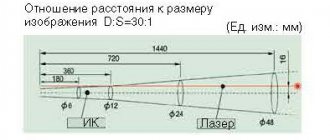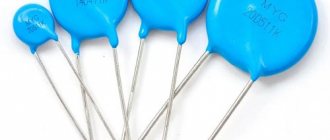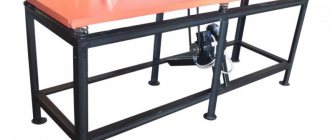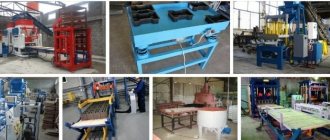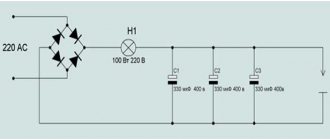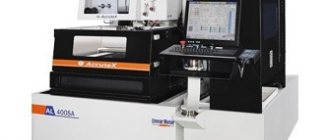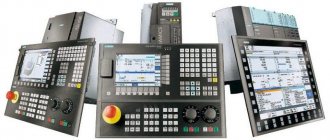For a long time, tenon joints have been used when assembling drawers, doors, windows and other frame structures. To accurately and quickly obtain such complex elements in wooden structures, a wood tenoning machine is used.
This equipment is used both in business and in large-scale production. It is indispensable in the manufacture of furniture, as well as in house construction and woodworking enterprises.
Types of tenoning machines
A tenon saw is a type of woodworking machine. There are samples of both imported and domestic production on the market. The fixing elements on it can be processed for subsequent connection of products at an angle, as well as for their merging (dovetail folds are used).
Machines for milling tenons are divided into frame machines and box machines according to their intended purpose.
In this case, frame units are:
- unilateral. In one pass, the tenons are processed on one side of the workpiece;
- two-way automated. The design of a tenoning machine involves placing supports on two columns and, accordingly, processing the workpiece on both sides.
Naturally, the productivity of double-sided tenoning machines is much higher than their analogues. There are several types of units, which differ in length, and they come in 2, 2.5, and 3 meters.
The cutting tools for them are cross-cut saws and cutters (disc and end) for processing straight tenons, lugs on frames and frames of various wooden structures.
The formation of box and dovetail tenons is done on specialized machines, mainly in large-scale and mass production. At the same time, there are two types of dovetail fixation: with rounded and sharp corners.
The first category is produced on multi-spindle tenoning machines. Such shaped protrusions are processed simultaneously on the mating surfaces using modular cutters. It is this connection that guarantees the durability and reliability of the fixing unit.
When producing the most complex oval dowels (small tenons) and those with a round shape, automatic tenoning machines with numerical control are used.
Tenon cutting machines for joinery and furniture production
Tenons and eyes are inevitable elements of almost all wood products, so machines for their formation occupy a significant place in the joinery and furniture production.
Table 1 shows the range of operations performed by these machines.
Table 1. Work performed on tenoning machines
Tenoning machines are divided into single- and double-sided. Single-sided machines are usually positional type machines. Double-sided machines simultaneously process both ends of the workpiece in pass-through mode. Based on the design of the formed tenons, frame and box machines are distinguished.
Frame tenoners mill frame tenons, usually with 1-2 tenons or lugs, on the ends of the lumber parts, which are then assembled into products such as frames or boxes. Box tenon cutters cut tenons along the face of panel parts, which are then assembled into box-type products (for example, radio equipment housings).
The simplest tenoning machines should be considered milling machines with a lower spindle, equipped with tenoning carriages. The disadvantage of such machines is that they have only one spindle, which is not enough to form a double tenon. In addition, these machines do not have a miter saw, which is necessary to form a high-quality end surface.
To form most frame tenons, one milling spindle is not enough. Therefore, a classic single-sided tenon cutter usually has three or four spindles (Fig. 1):
- saw unit for filing the end and obtaining a high-quality end surface;
- upper and lower cutter heads for milling tenon shoulders; — milling head with a disk cutter for forming the eye of the tenon.
Rice. 1 Diagram of a one-sided tenoning machine: 1 - hydraulic clamps; 2 - table; 3 - saw; 4 — tenoning cutters; 5 — adjustment screws; 6— disk (lugged) cutter; 7— guide; 8—chain; 9—bed; 10— emphasis; 11 - workpiece; 12 - support block; 13 — carriage; 14 - reference ruler.
The carriage on which the workpiece is rigidly fixed can be manually or mechanically driven.
In Russia, tenoning machines are produced by KODOS-Stankoagregat (SHO 16-4M brand) and the Lipetsk Machine Tool Plant (ShOB-20 brand). The machines allow you to form tenons and eyes up to 160 mm long. The machine table has the ability to tilt, which allows you to form inclined tenons - up to 20° to the workpiece face. The carriage with the fixed workpiece performs a reciprocating movement from a hydraulic drive. The machines find their main application in the production of window and door blocks. For the bars of window sashes, single tenons are usually used, for the bars of window and door frames - double tenons.
Tenons can also be cut on so-called corner centers for processing parts of window blocks. The corner center is a combination of a single-side tenoning machine and an under-spindle router. On such a unit, a complex of works is performed on the production of window sashes: first, tenons and eyes are formed on both ends of the workpieces, and then the profile is milled during the longitudinal movement of the workpiece relative to the cutters. Saws for sawing off glazing beads can also be provided here. After assembling the sashes on the same machine, they are fitted around the perimeter.
Such corner centers (multi-purpose machining centers) are produced from Stavropol (model TsBR-10) and the Lipetsk Machine Tool Plant (models MDDTs-15 and MDTs-25 - see Fig. 2).
Rice. 2 Multipurpose corner processing center MDTs-25 of the Lipetsk Machine Tool Plant
Lipetsk units are a combination of a single-sided tenoning machine ShOB-20 and a longitudinal milling machine SFP-1. The technological cycle of processing a part on a unit consists of the following operations:
- installation of the workpiece on the ruler along the slider;
- workpiece clamp;
- end processing with a saw spindle;
- end processing with a milling spindle - cutting tenons and lugs;
- carriage return;
- part release;
- reinstallation of the part;
- then repeat steps 2-5;
- feeding the workpiece for edge milling,
- output of the processed workpiece.
Double-sided tenoning machines are designed to form tenons simultaneously on both ends of workpieces (Fig. 3). They are especially often used in workshops for the production of window and door blocks, since here every structural detail has straight tenons. Double-sided machines have on their frame one fixed unit and one movable unit, which allows you to adjust the machine to a given length of the part. The pass-through method of operation is ensured by a workpiece supply system in the form of two chain conveyors with stops.
Rice. 3 Double-sided tenoning machine MX 3825B and its operation diagram (V-Hold, China)
The machine has eight cutting supports, a conveyor with steplessly variable feed speeds, and top drive clamping devices. The first along the material supply are two saw supports for trimming the workpiece. Behind the saw supports there are two slotted ones. The last ones along the material supply are four vertical (upper and lower) tenoning supports. The machine can be easily integrated into the production line for manufacturing doors and windows.
Machines operating according to a similar scheme are also produced by the Canadian company Beaver and the Taiwanese Leadermac. The machines use so-called jumping cutters, or rebound cutters, which help avoid chipping the wood at the corners of the part. The main cutter is moved slightly to the side, and the tenon formation ends with another cutter with the opposite direction of rotation.
The main feature of box tenon cutters is the ability to form tenons on large-width parts. The domestic machine ShPA-40 (Fig. 4) has a working width of 400 mm and is used in the production of radio equipment housings, packaging for expensive devices and other goods.
Rice. 4 Box tenon cutter ShPA-40 with automatic feed: 1 — control panel; 2 - electric motor; 3 — hydraulic drive control; 4 — working shaft bearing; 5—hydraulic clamp; 6—belt drive; 7—blanks; 8 - table; 9 - hydraulic hose; 10 — hydraulic cylinder for lifting the table.
The machine has a horizontal milling shaft. The tenons are cut when the table with the workpieces attached to it is moved vertically. In our country, box tenon cutters ShLH-Z for dovetail tenons and double-sided Sh2PA for straight tenons were also produced.
Machines from the Italian company OMEG for box tenons mill up to four types of tenons with adjustable pitch according to the shape shown in Figure 5. The machine unit can process both parts of the dovetail joint separately or simultaneously, depending on the program set by the operator. The length of the workpiece being processed ranges from 200 to 1500 mm, and the width - from 60 to 770 mm, depending on the brand of the machine.
Rice. 5 A cutter for forming dovetail lugs from OMEG (Italy) and a general view of the connection with box tenons
Modern imported tenoning machines have the following features:
- extended milling spindles, which allows you to install two or three sets of tools for tenons of various designs on them and very quickly change to another task by vertical positioning the spindle;
- semi-automatic or automatic installation of tools (mills, cutter heads, saws) into the working position;
- digital indexing of the most important machine operating parameters.
In addition to straight tenons, in furniture production it is necessary to form inclined, round or rounded tenons. For such purposes, there are special tenon-cutting machines in which the formation of round and rounded tenons occurs in positional mode. When the workpiece is rigidly secured, the cutting tool makes a closed movement along the contour of the tenon (Fig. 6). Such machines are most widely used in the production of armchairs and chairs.
Rice. 6 Tenon-cutting machine ShDS-1 (Kodos-Stankoagregat) and sketches of tenons cut on this machine
The machine has two tables operating in automatic alternating mode. The thickness, width and inclination of the tenon can be adjusted without turning off the machine.
A similar machine is produced by the Italian company Bacci Paolino. The machine allows you to produce any type of furniture tenon in any plane. Adjustment of the spindle movement is carried out mechanically and takes a few seconds. The standard equipment of the machine allows you to produce tenons without chipping the wood at the output of the tool. The thickness, width and inclination of the tenon are adjusted without stopping the machine, using an external adjustment wheel.
On the market you can also find double-sided computer-controlled machines for forming tenons of various shapes, including rounded ones (Fig. 7).
This machine has a system for automatic loading/unloading of straight and curved parts, as well as CNC settings of all parameters separately for the right and left units.
Machines for cutting toothed tenons are structurally close to single-sided tenon cutting machines. The difference lies in the use of special cutters, the design of which is determined by the desired profile of the tenons. Typically today, mini-spikes with a length of 10-15 mm are used for splicing. A miter saw is installed in front of the milling head to clean the end before milling it.
It is necessary to distinguish between machines for cutting horizontal and vertical tenons. Horizontal tenons are cut along the edge of the workpiece, and vertical tenons are cut along the face. For both types of tenons, there are both positional and through-cut machines.
In Russia, machines for cutting tenons for the purpose of subsequent splicing of short lengths of lumber are produced by several enterprises (in Veliky Novgorod, Stavropol, Lipetsk, Kostroma, Tver). Figure 8 shows a machine for cutting mini-spikes SFSh-005 from Veliky Novgorod.
Rice. 7 Automatic CNC tenoning machine MSZ 2000 (supplier MS-group-Krasnodar) (“Backout”, Veliky Novgorod)
Rice. 8 Tenon-cutting machine for cutting toothed mini-tenons SFS-05
A stack of blanks is placed with their edges on the carriage, aligned with their ends against the stop, and fixed with a pneumatic clamp. The blanks can be laid face down to form horizontal tenons or placed on the edge to form vertical tenons. Then the carriage is mechanically fed to the cutting tool, and after cutting the tenons it returns to its original position.
To form tenons at the second end, the stack of workpieces is rotated 180°, again based on the second end and the cutting cycle is repeated, while the table automatically shifts in height by half a pitch of toothed tenons (the connection pitch is 3-5 mm). The tenoning machine is equipped with an original scoring saw unit that reduces the carriage stroke, which increases labor productivity. The width of the package of blanks is up to 400 mm. The carriage feed speed is adjustable. The minimum length of the workpiece is 200 mm, the maximum is 730 mm, the processing cycle of one pack is 1-2 minutes.
Instead of a carriage, such machines can be equipped with a table with a rotary conveyor, which reduces the time of auxiliary operations and increases the productivity of the machine. After processing one end, the workpiece clamp is removed, the conveyor is rotated (manually or automatically), the workpieces are placed at opposite ends, clamped again, and filing and toothed spikes are formed on the second end of the workpieces. This design, however, is designed only for short workpieces, usually 0.7-1 m long.
The pass-through method of milling horizontal tenons is implemented in a line where there is a transverse conveyor, along the edges of which there are two tenon-cutting machines. During movement, the board is first based and milled along the right end, and then along the left (Fig. 9).
The situation is completely different when cutting vertical tenons on boards of medium and long length. In the production of laminated beams up to 12 m long or more, vertical tenons are used for splicing, so tenoning machines with a carriage are not suitable here.
Rice. 9 Line for forming serrated horizontal tenons for long boards (Weinig, Germany)
Vertical profiles are used mainly in the construction of wooden structures, as well as in the manufacture of windows and frames. This method guarantees the largest bonding area, which means the strongest tooth-and-wedge joint possible.
In splicing lines, positional machines are used for piece-by-piece cutting of toothed tenons (Fig. 10), in which the working movement from top to bottom is performed by a milling spindle.
Rice. 10 Machine for vertical formation of toothed tenons (Weinig, Germany)
Specifications
The operator’s functions when working on an automatic machine are reduced to loading and turning workpieces, starting or stopping the cycle. Important indicators of tenoning units are:
- largest peg size;
- the smallest thickness;
- groove height;
- width;
- maximum workpiece size;
- spindle speed;
- engine power.
In addition to the characteristics for classifying the machine, the parameters of the cutting tool are indicated: saw diameter, type and size of cutter.
Often on large production lines such equipment is installed to the ceiling. The machines are additionally fixed with clamping devices, where the workpieces are processed by scoring saws, followed by the formation of tenons on milling supports.
The feed is adjusted smoothly using a variator. To create a high-quality surface of the mating elements, the spindle speed should be about 700 rpm.
Principle of operation
When forming pegs, a sawing and milling procedure is usually used. An appropriate cutting tool is used to obtain the tenon joint surfaces.
Attention! Whatever the shape of the tenons, the initial operation is to trim the workpiece.
For the most common models that use milling during processing, the machines are equipped with four spindles - three milling and one sawing. One or more workpieces can be loaded onto the carriage table, and they are aligned with their edges along the ruler and their ends along the stop bar.
The tenon is formed as a result of end milling. When the cutting tool comes out, chips may appear on the edges, so to prevent them, a support block is mounted on the ruler, and some machines also provide for the application of glue to the surface being processed.
After turning on the feed mechanism, the product is automatically fixed due to the side and top hydraulic clamps. The carriage with the workpiece begins to move at a certain speed along two guides relative to the cutting tools.
In this case, during the movement of the carriage, a spike of the desired configuration is formed on the structure, then the device, having reached the stop (limit switch), returns to its original position. Here the finished product is replaced with a blank, and the cycle repeats again.
If the machine is double-sided, the process of forming tenons occurs on both sides of the workpiece.
CNC Milling Machine for Tenon Cutting of Chairs and Tables CNC-200
Purpose:
Designed for forming vertical and horizontal rounded tenons on straight and curved parts.
Application area:
The machine is used in furniture and carpentry industries engaged in the serial production of chairs and tables.
Distinctive features:
- Two independent working tables can achieve left and right operation, improve work efficiency.
- A stepless change in feed speed is used, which is stable for each type of wood.
- Table guides are straight and of excellent precision
- The width and depth of the tenon can be adjusted, the size is stable
- Central control panel, easy to operate, high quality performance.
Design:
The tenoning machine (with a rounded tenon shape) can produce horizontal, vertical and inclined tenons. The machine includes a base with two fixed tables, one head (tool), which moves from one table to another through a special cycle described below.
Accuracy:
The movement of the tool has been specially designed to be able to process the tenons with high precision and to avoid any possible splitting. This result is achieved by constantly working the tool in the direction of the grain and moving in such a way that if the processing is completed, the tool does not need to load the already processed part. The result of the second transition may be insufficient precision in the quality of the spikes. The operating speed is not reduced by this cycle if the tool is positioned correctly during transfer from one table to another.
Tables:
Further accuracy is guaranteed by fixed tables. As you know, the more stationary the workpiece, the more accurate its processing. All table settings (height, cross, front and back tilt) are easily adjusted using the handwheel or using the adjusting screw with the same wrench provided as equipment. Any setting has a reading scale and a mechanical zero point of absolute accuracy, which is calibrated during assembly of the machine. Clamping and unlocking of more standard settings is done using a handle. A positioning guard placed on the table is used as a regulating device for making tenons at an angle of 0-45°. The front and rear guards are complete with a starting point for easy execution. The pneumatic clamping cylinder on each table, complete with a non-rotating guard, is positioned to avoid interference with the operator during loading/unloading and to ensure ease of adjustment. You can set up two tables so that you can do both the left and right legs in one pass.
Tenon milling:
Thanks to the fixed tables, the movement of the tool can be completely secured, leaving only two small holes for the workpiece to be processed. This not only protects the operator from accidental contact, but also improves the efficiency of the dust hood and reduces the noise generated by the machine.
Advantages:
The special actuating movement carried out by the tool and the fixed tables guarantees flawless tenoning even on very long workpieces, since the workpiece is always stationary during processing. Fixed tables allow the operator to work in a relaxed environment without the need to constantly move to avoid table movement and without the need to use a suitable support device for long workpieces such as bed sides, benches, lawn furniture and the like. The anti-splitting cycle operates continuously and guarantees good quality without increasing processing time. On the contrary, this happens on competitive machines, where time is wasted and quality deteriorates because the tool must re-deform the already machined part.
| Two pneumatic clamps, the ability to install the workpiece at an angle to the X axis |
| Centralized lubrication system |
| Possibility of tilting tables along the Y axis |
| High quality electric guides |
| Convenient and concise control panel |
Homemade tenoning machine
Today there are all opportunities for entrepreneurial activity, while many are engaged in the manufacture of furniture, wooden doors and windows, where connecting tenons are indispensable when assembling the product. And since tenon cutting machines are not cheap, at first a homemade unit is quite suitable for obtaining fixing elements.
It is easy to make on your own, which will save a lot of money when organizing production. Moreover, there are different options for the manufacture of such machines, where the basic element can be a stationary engine, an angle grinder, a jigsaw, and even an electric drill.
Let's consider making a do-it-yourself tenoning machine based on a grinder with a disk cutter positioned in a horizontal position.
As in a factory machine, here, in addition to the engine and cutting tool, there are two components:
- bed;
- tabletop.
The frame must be strong and stable, since it is the base part of the unit on which the device for fastening the workpiece and the grinder with the cutter are installed. This component of the tenoning machine can vary in design and be manufactured without drawings. For example, it can be made from metal corners, and a sheet of chipboard can be fixed on them.
The size of the tabletop must correspond to the intended workpiece. It also contains clamps and a control ruler.
The bed guides must be strictly perpendicular to the movement of the tabletop when milling connecting elements. The quality of the connection between the studs and lugs depends on this.
Description
The MULTICUT universal tenoning and slotting machine for wood is designed to automate a variety of carpentry operations in the serial and small-scale production of furniture, doors, and wooden interior parts.
The machine performs the following operations:
- Manufacturing of tongue-and-groove joints in various variations (single, double, multiple, round, Dovetail, box tenon, toothed tenon joints;
- Milling of seats for insertion of locks and canopies;
- Shaped cutting of joinery contours;
- Milling decorative elements on carpentry parts.



